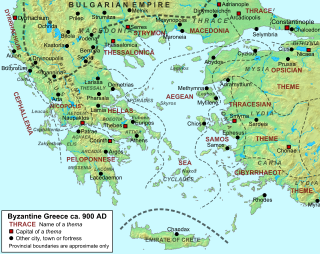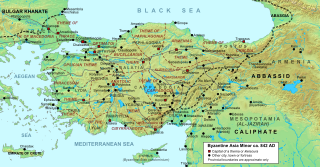Neokastra (Greek : Νεόκαστρα, "new fortresses", formally θέμα Νεοκάστρων; in Latin sources Neocastri or Neochastron) was a Byzantine province (theme) of the 12th–13th centuries in north-western Asia Minor (modern Turkey).

Greek is an independent branch of the Indo-European family of languages, native to Greece, Cyprus and other parts of the Eastern Mediterranean and the Black Sea. It has the longest documented history of any living Indo-European language, spanning more than 3000 years of written records. Its writing system has been the Greek alphabet for the major part of its history; other systems, such as Linear B and the Cypriot syllabary, were used previously. The alphabet arose from the Phoenician script and was in turn the basis of the Latin, Cyrillic, Armenian, Coptic, Gothic, and many other writing systems.

The themes or themata were the main military/administrative divisions of the middle Byzantine Empire. They were established in the mid-7th century in the aftermath of the Slavic invasion of the Balkans and Muslim conquests of parts of Byzantine territory, and replaced the earlier provincial system established by Diocletian and Constantine the Great. In their origin, the first themes were created from the areas of encampment of the field armies of the East Roman army, and their names corresponded to the military units that had existed in those areas. The theme system reached its apogee in the 9th and 10th centuries, as older themes were split up and the conquest of territory resulted in the creation of new ones. The original theme system underwent significant changes in the 11th and 12th centuries, but the term remained in use as a provincial and financial circumscription until the very end of the Empire.

Turkey, officially the Republic of Turkey, is a transcontinental country located mainly in Western Asia, with a smaller portion on the Balkan Peninsula in Southeast Europe. East Thrace, located in Europe, is separated from Anatolia by the Sea of Marmara, the Bosphorous strait and the Dardanelles. Turkey is bordered by Greece and Bulgaria to its northwest; Georgia to its northeast; Armenia, the Azerbaijani exclave of Nakhchivan and Iran to the east; and Iraq and Syria to the south. Istanbul is the largest city, but more central Ankara is the capital. Approximately 70 to 80 per cent of the country's citizens identify as Turkish. Kurds are the largest minority; the size of the Kurdish population is a subject of dispute with estimates placing the figure at anywhere from 12 to 25 per cent of the population.
Its origin and extent are obscure. According to Niketas Choniates, the theme was founded by Manuel I Komnenos (r. 1143–1180) between 1162 and 1173. Manuel I scoured the region around three cities—Chliara (mod. Kırkağaç), Pergamon and Adramyttion—from the Turkish bands that raided it, rebuilt and refortified the cities and established forts in the countryside and made them into a separate province under a governor titled harmostes ("supervisor") by the archaizing Choniates, but whose actual title in all probability must have been doux . [1] [2] The imperial chrysobull of 1198 to the Venetians on the other hand mentions Adramyttion apart from the Neokastra, and the Partitio Romaniae of 1204 mentions the province of Neokastra as being entirely separate from all three cities. [1] [2] The Byzantinist Helene Ahrweiler interpreted the evidence to suggest that Neokastra did indeed originally encompass the three cities, but that in 1198 Adramyttion may have formed a separate district, and that the separation between the cities and the province evidenced in the Partitio was the result of a copyist's error. [3]

Niketas or Nicetas Choniates, whose real surname was Akominatos (Ἀκομινάτος), was a Greek Byzantine government official and historian – like his brother Michael Akominatos, whom he accompanied to Constantinople from their birthplace Chonae. Nicetas wrote a history of the Eastern Roman Empire from 1118 to 1207.

Manuel I Komnenos was a Byzantine Emperor of the 12th century who reigned over a crucial turning point in the history of Byzantium and the Mediterranean. His reign saw the last flowering of the Komnenian restoration, during which the Byzantine Empire had seen a resurgence of its military and economic power, and had enjoyed a cultural revival.

Kırkağaç is a town and district of Manisa Province in the Aegean region of Turkey. According to the 2000 census, population of the district is 48,303 of which 25,093 live in the town of Kırkağaç. The district covers an area of 549 km2 (212 sq mi), and the town lies at an elevation of 188 m (617 ft).
The theme survived the destruction of the Byzantine Empire by the Fourth Crusade, and was retained by the Empire of Nicaea, where it constituted, along with the Thracesian Theme to the south, the most important provinces. [4] The boundaries of the Nicaean province were different, however: Adramyttion was lost to the new Latin Empire, and Pergamon was abandoned and fell in ruins. The account of George Akropolites, reflecting the new situation, mentions Neokastra apart from Chliara and Pergamon, and records the village of Kalamos (mod. Gelembe) as the northernmost point of the theme, at the Nicaean frontier zone with the Latins. [2] [5] [6] On the basis of Akropolites' passage, the scholar Ruth Macrides suggested an alternative reading of Choniates' passage, which would place the original theme of Neokastra immediately to the east of the three cities. [6] Ahrweiler also suggested that the Nicaean-era province of Neokastra extended as far south as Magnesia or Sardis, [4] but this is conjectural. [2] A handful of governors of the theme are known: Manuel Kalampakes ca. 1284, a certain Libadarios, who was involved in the revolt of Alexios Philanthropenos in 1296, and the parakoimomenos Constantine Doukas Nestongos, active in 1303/4, whom Ahrweiler identifies as the theme's last known doux. The region fell shortly thereafter to the Anatolian beyliks of Karasi and Sarukhan. [2] [7]

The Fourth Crusade (1202–1204) was a Latin Christian armed expedition called by Pope Innocent III. The stated intent of the expedition was to recapture the Muslim-controlled city of Jerusalem, by first conquering the powerful Egyptian Ayyubid Sultanate, the strongest Muslim state of the time. However, a sequence of economic and political events culminated in the Crusader army sacking the city of Constantinople, the capital of the Greek Christian-controlled Byzantine Empire.

The Empire of Nicaea or the Nicene Empire was the largest of the three Byzantine Greek rump states founded by the aristocracy of the Byzantine Empire that fled after Constantinople was occupied by Western European and Venetian forces during the Fourth Crusade. Founded by the Laskaris family, it lasted from 1204 to 1261, when the Nicaeans restored the Byzantine Empire in Constantinople.

The Thracesian Theme, more properly known as the Theme of the Thracesians, was a Byzantine theme in western Asia Minor. Created either in the mid-7th or the early 8th century as the cantonment of the former Army of Thrace, whence it was named, it was one of the larger and more important themes of the Empire throughout its existence. The Thracesian Theme was one of the longest-lived themes, surviving until the region was conquered by the Turks in the early 14th century.










